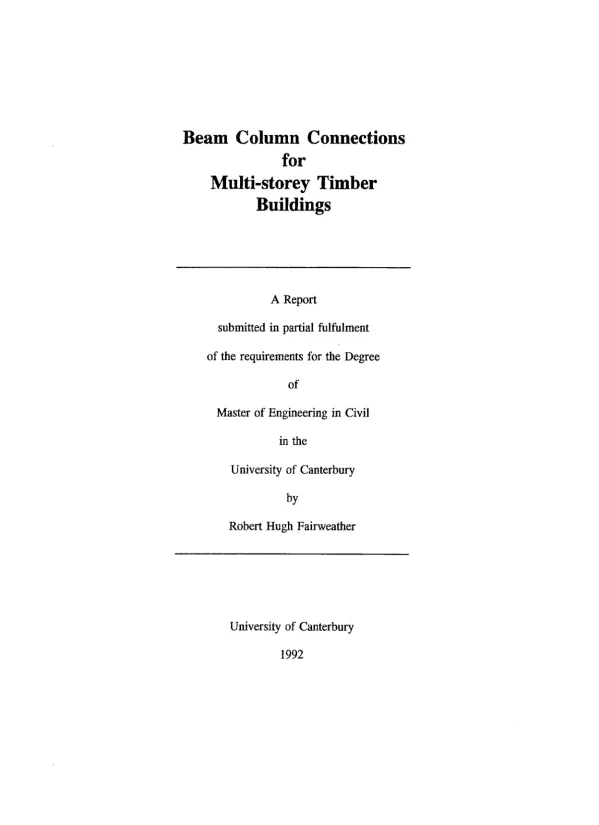
Seismic Performance of Epoxy-Bonded Steel Dowel Connections in Multi-storey Timber Buildings
Document information
| Author | Robert Hugh Fairweather |
| School | University of Canterbury |
| Major | Civil Engineering |
| Year of publication | 1992 |
| Place | Christchurch |
| Document type | thesis |
| Language | English |
| Number of pages | 138 |
| Format | |
| Size | 7.39 MB |
- Timber Engineering
- Seismic Testing
- Epoxy Connections
Summary
I. Introduction
The document begins with an overview of the Seismic Performance of Epoxy-Bonded Steel Dowel Connections in Multi-storey Timber Buildings. It emphasizes the importance of understanding how these connections behave under seismic loads. The introduction outlines the scope of the report, detailing the objectives and the significance of the research. The author, Robert Hugh Fairweather, presents a clear rationale for the study, highlighting the increasing use of timber in construction and the need for reliable connection methods that can withstand seismic forces. The introduction sets the stage for the subsequent sections, which delve into the testing methodologies and results. It is crucial to note that the report aims to contribute to the body of knowledge regarding timber structures and their performance during earthquakes, a topic of growing relevance in civil engineering.
II. Testing Methodology
The testing methodology section describes the experimental setup used to evaluate the epoxy-bonded connections. Eight different connection types were tested under simulated seismic loads. The report details the materials used, including mild steel deformed reinforcing bars and high strength threaded rods. The author explains the significance of using various epoxy types and connection configurations to assess their performance. The testing procedures included load-controlled and deflection-controlled cycles, which are essential for understanding the ductile behavior of the connections. The methodology is robust, allowing for a comprehensive analysis of how these connections perform under stress. The findings from this section are critical for engineers looking to design safer timber structures that can endure seismic events.
III. Analysis of Results
In the analysis section, the document presents the results of the tests conducted on the connections. The author discusses the initial stiffness of the connections and how it relates to their overall performance. Key metrics such as interstorey drift and yield displacement are analyzed to provide insights into the behavior of the connections under load. The report highlights that several connections exhibited excellent ductile behavior, which is vital for ensuring that structures can absorb and dissipate energy during an earthquake. The analysis also includes a discussion on the stresses in the members and shear stresses in the joint region, providing a detailed understanding of the forces at play. This section is invaluable for practitioners in the field, as it offers empirical data that can inform future designs and improve the resilience of timber buildings.
IV. Practical Applications
The practical applications of the research findings are significant for the construction industry. The document emphasizes the potential for epoxy-bonded steel dowel connections to enhance the seismic performance of timber buildings. By demonstrating that these connections can be designed using a capacity design procedure, the author provides a pathway for engineers to implement these methods in real-world projects. The findings support the development of building codes and standards that prioritize safety in seismic-prone areas. Furthermore, the report encourages further research into alternative materials and connection types, fostering innovation in timber construction. The practical implications of this study extend beyond academic interest, offering tangible benefits for the design and construction of safer, more resilient structures.
Document reference
- Seismic Performance of Epoxy-Bonded Steel Dowel Connections in Multi-storey Timber Buildings (Robert Hugh Fairweather)
- West System Z105/Z205 Two Component Epoxy
- Hilti HIT C100 Injection Technique
- Capacity Design Procedure
- Examples of Epoxy Dowel Use in Timber Joints
